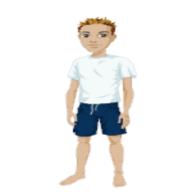Height of a boy is 1.5 m and top of his head is 0.1m above his eyes. He stands 1 m in front of a plane mirror perpendicular to the floor and want to cut a mirror of a minimum length that can show his whole image.
What is the length of the mirror?
What is the height of the mirror fixed above the ground floor?
Can the boy still see his whole image if he go towards to the mirror? Why?
Tough physics question
2007-02-21 7:06 pm
回答 (3)
2007-02-22 8:10 am
✔ 最佳答案
First of all, please take a look with reference to the diagram below:圖片參考:http://i117.photobucket.com/albums/o61/billy_hywung/Mirrorbody.jpg
【此圖乃本人自製圖片,未經本人同意勿擅自連結或使用】
Suppose the boy stands straight and the mirror is also vertical, then lines L1 and L2 are perpendicular to his body.
Looking into the 2 pairs of right-angled triangles (one blue pair and one red pair), and together with the law of reflection, we can prove that the blue pair of triangles are congurent (reason: ASA) and so do the pair of red triangles.
Hence we can conclude that L1 meets the boy's body at the point between his top and his eyes and L2 meets the boy's body at the point between his eyes and his feet.
So to speak, L1 is 1.45m above the ground and L2 is 0.70m above the ground. Therefore the minumum required length of the mirror for the boy to be able to see his body's whole image is (1.45-0.70) = 0.75m which is half of his height.
In fact, for anyone to be able to his/her whole body's image, the mirror length should be half of his/her height.
And as D (the distance between the boy and the mirror) varies, the two pairs of right-angle triangles are still congurent and therefore the height of L1 and L2 above the ground are still the same, thus not affecting the minumum length of the mirror.
∴ If the boy moves towards the mirror, he still can see his whole image.
參考: My Physics knowledge
2007-02-21 9:41 pm
The length of the mirror
= height of the boy / 2
= 1.5 / 2
= 0.75 m
The height of the mirror fixed above the ground floor
= height of eye level / 2
= (1.5 - 0.1) / 2
= 0.7 m
The boy can still see his whole image if he goes towards to the mirror.
It is because the above calculations are independent of his distance from the mirror.
You may also draw two triangles with the same base but different heights. Then, draw a staight line parallel to the base at the half of the respective height of each triangle. The same length of the middle lines can be observed.
= height of the boy / 2
= 1.5 / 2
= 0.75 m
The height of the mirror fixed above the ground floor
= height of eye level / 2
= (1.5 - 0.1) / 2
= 0.7 m
The boy can still see his whole image if he goes towards to the mirror.
It is because the above calculations are independent of his distance from the mirror.
You may also draw two triangles with the same base but different heights. Then, draw a staight line parallel to the base at the half of the respective height of each triangle. The same length of the middle lines can be observed.
2007-02-21 7:29 pm
Length of the mirror = height/2 = 0.75m
Height of the mirror fixed above the ground floor = height of the eye / 2 = 0.7m
Can the boy still see his whole image if he go towards to the mirror? Why?
-- Yes
-- By drawing a ray diagram, you will find out if the mirror length and position do not change, the light rays from his body can still enter his eyes no matter how far he goes towards the mirror.
第1,2 條就可以記左佢, 屬經常出既題型
第3條就通常都唔會咁問既~~
Height of the mirror fixed above the ground floor = height of the eye / 2 = 0.7m
Can the boy still see his whole image if he go towards to the mirror? Why?
-- Yes
-- By drawing a ray diagram, you will find out if the mirror length and position do not change, the light rays from his body can still enter his eyes no matter how far he goes towards the mirror.
第1,2 條就可以記左佢, 屬經常出既題型
第3條就通常都唔會咁問既~~
收錄日期: 2021-04-13 16:41:01
原文連結 [永久失效]:
https://hk.answers.yahoo.com/question/index?qid=20070221000051KK01169



